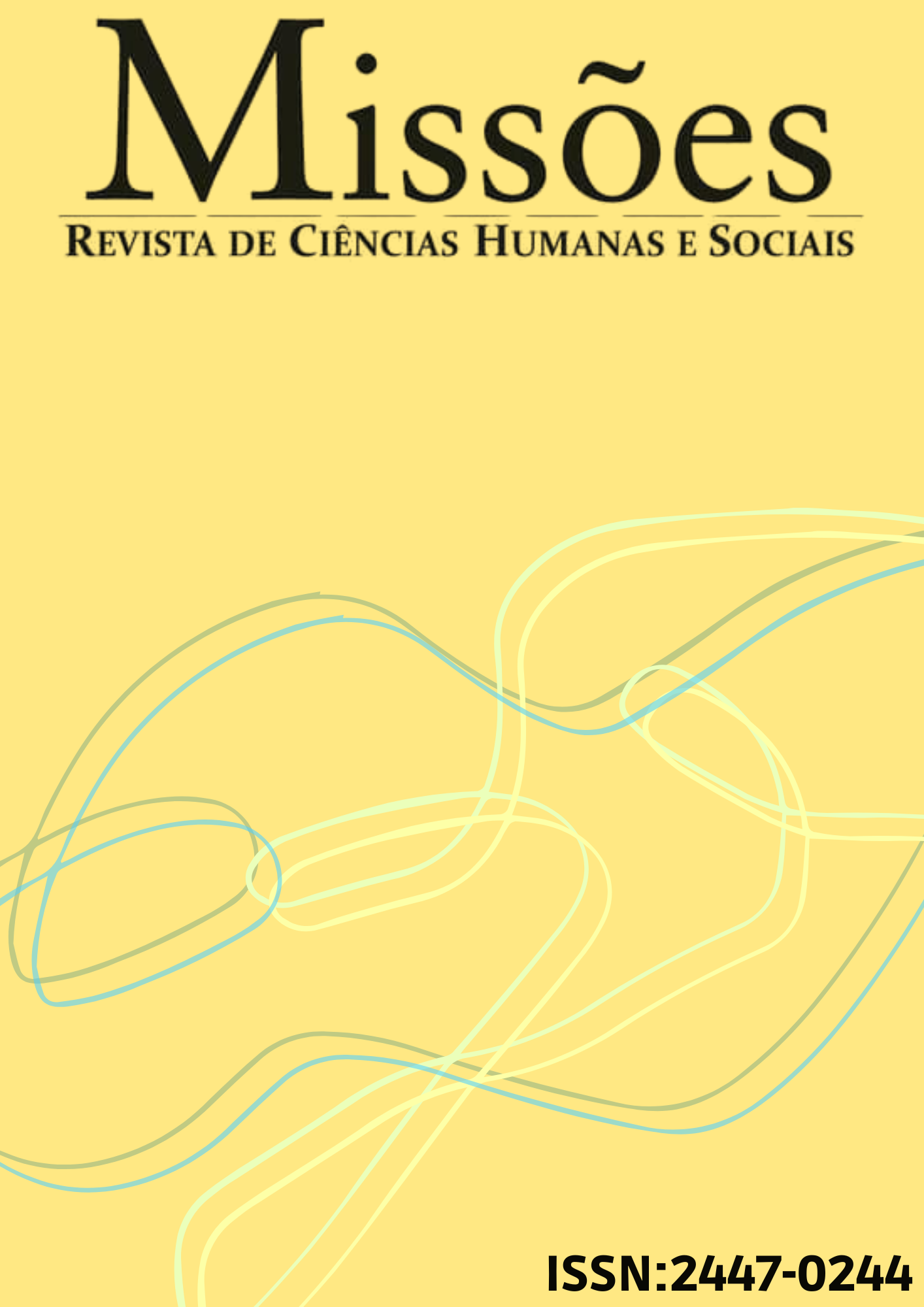MULHERES E BRUXAS
O COTIDIANO FEMININO RETRATADO NAS IMAGENS DE BRUXARIA (1500 – 1589)
Visualizações: 225DOI:
https://doi.org/10.62236/missoes.v9i3.56Palavras-chave:
Bruxaria, Germânia, Primeira Modernidade, GêneroResumo
A chamada Primeira Modernidade europeia foi um período extremamente conturbado, que passou por diversas crises e profundas mudanças sociais, econômicas e políticas. Nesse contexto, a religião tomou um papel central nas discussões teóricas, em especial após a Reforma Religiosa e seus desdobramentos, que refletiram no modo como as sociedades se estruturavam. Nesta pesquisa, o objetivo principal foi estudar como o trabalho iconográfico de determinados autores contribuiu para a construção de um imaginário que colocava a mulher e todo o seu universo simbólico como um dos focos do debate demonológico, fazendo assim uma conexão entre o feminino e o demoníaco. Para tanto, procuramos estudar uma bibliografia que dialogasse especificamente com os autores e obras elencadas como fontes da pesquisa; entretanto o foco principal deste trabalho foi nos debruçarmos sobre as fontes em si, procurando colocar em prática tudo que foi lido anteriormente. Dessa forma, esperamos ter contribuído não apenas com os estudos em bruxaria, mas também com o debate em torno das questões de gênero no período.
Downloads
Referências
BARTRUM, Giulia. Albrecht Dürer and his Legacy. British Museum Press, 2002.
BEHRINGER, Wolfgang. Witchcraft and Persecutions in Bavaria: popular magic, religious zealotry and reason of state in early modern Europe. Tradução. Cambridge: Cambridge University Press, 1997.
BEVER, Edward. Witchcraft, Female Agression and Power in the Early Modern Community. Journal of Social History, v. 35 n. 4, p. 955-988. 2002. DOI: https://doi.org/10.1353/jsh.2002.0042
BRADY Jr; THOMAS A. The Social Place of a German Renaissance Artist: Hans Baldung Grien (1484/85-1545) at Strasbourg. Central European History, v. 8, n. 4, p. 295-315, 1975. DOI: https://doi.org/10.1017/S0008938900017994
BRIGGS, Robin. ‘By the Strength of Fancie’: Witchcraft and the Early Modern Imagination. Folklore, v. 115, n. 3, p. 259-272. 2004. ____________. Witches & Neighbors: The Social and Cultural Context of European Witchcraft. New York: Penguin, 1996. DOI: https://doi.org/10.1080/0015587042000284257
CLARK, Stuart. Pensando com Demônios: a ideia de bruxaria no princípio da Europa Moderna. Tradução. São Paulo: Editora da Universidade de São Paulo, 2006. ___________. Inversion, Misrule and the Meaning of Witchcraft. Past & Present, n. 87, p. 98-127. 1980.
HULTS, Linda C. ‘Dürer’s Lucretia’: speaking the silence of women. Signs, v. 16, n. 2, p. 205-237. 1991. DOI: https://doi.org/10.1086/494658
KOERNER, Joseph Leo. The Mortification of the Image: Death as a Hermeneutic in Hans Baldung Grien. Representations, n. 10, p. 52-101. 1985. DOI: https://doi.org/10.2307/3043800
KORS, Alan C.; PETERS Edward. Witchcraft in Europe: 1100-1700. Filadélfia: University of Pennsylvania Press, 1972.
LEHMANN, Hartmut. The Persecution of Witches as Restoration of Order: The Case of Germany, 1590s-1650s. Central European History, v. 21, n. 2, p.107-121. 1988. DOI: https://doi.org/10.1017/S000893890001270X
NAVARRO, Gaspar. Tribunal de superstición ladina, explorador del saber, astucia, y poder del demonio; en que se condena lo que suele correr por bueno en hechizos, agüeros, ensalmos, vanos saludadores, maleficios, conjuros, arte notoria, cabalista, y paulina y semejantes acciones vulgares. Huesca: Pedro Blusón, 1631.
PANOFSKY, Erwin. Significado nas Artes Visuais. Tradução. São Paulo: Perspectiva, 3ª edição, 1991.
RODRIGUES, Kethlen Santini. O Surgimento da Imagem da Bruxa nas Artes Visuais: Bruxaria e Sexualidade nas obras de Albrecht Dürer e Hans Baldung Grien. 2018. Dissertação (Mestrado em História) - Instituto de Artes da Universidade Federal do Rio Grande do Sul, Porto Alegre.
ROPER, Lyndal. Oedipus and the Devil: witchcraft, sexuality and religion in early modern Europe. Editora Routledge, Nova Yorque, 2ª Ed. 1995. ________. Witch Craze: terror and fantasy in baroque Germany. Yale University Press, 2004, Londres. ________. Witchcraft and the Western Imagination. Transactions of the Royal Historical Society, Sixth Series, v. 16, p. 117-141. 2006.
ROWLAND, Robert. Fantasticall and Devilishe Persons: European witch-beliefs in comparative perspective. In ANKARLOO, Bengt; HENNINGSEN, Gustav (ed.). Early Modern European Witchcraft: Centres and Peripheries. Oxford: Clarendon Press, 1990. DOI: https://doi.org/10.1093/oso/9780198219897.003.0007
STUARD, Susan. The Domination of Gender: women’s fortunes in the High Middle Ages. Boston, 1987.
THOMAS, Keith. Religião e o Declínio da Magia: Crenças populares na Inglaterra, séculos XVII e XVIII. Tradução. São Paulo: Companhia das Letras, 1991.
THURSTON, Robert W. The Witch Hunts: A History of the Witch Persecutions in Europe and North America. Nova Yorque: Routledge, 2013. DOI: https://doi.org/10.4324/9781315834481
TURNER, James Grantham (ed.). Sexuality and Gender in Early Modern Europe: institutions, texts, images. Cambridge University Press, Cambrige, 1993.
TUTLLE, Virginia. Lilith in Bosch's ‘Garden of Earthly Delights’. Simiolus: Netherlands Quarterly for the History of Art, v. 15, n. 2, p. 119-130. 1985. DOI: https://doi.org/10.2307/3780660
VIGARELLO, Georges (dir.). História do Corpo, vol. 1: Da Renascença às Luzes. Tradução. Petrópolis: Vozes, 2012.
WAIT, Gary K. Heresy, Magic and Witchcraft in Early Modern Europe. Palgrave Macmillan, 2003. DOI: https://doi.org/10.1007/978-0-230-62912-7
WELCH, Christina. Death and the erotic woman: the European gendering of mortality in times of major religious change. Journal of Gender Studies, Vol. 24, No. 4, 2015. DOI: https://doi.org/10.1080/09589236.2014.950557
ZIKA, Charles. The Appearance of Witchcraft: print and visual culture in sixteenth-Century Europe. Nova Yorque: Routledge, 2007. ___________. Cannibalism and Witchcraft in Early Modern Europe: reading the visual images. History Workshop Journal, n. 44, p. 77-105. 1997. DOI: https://doi.org/10.1093/hwj/1997.44.77


